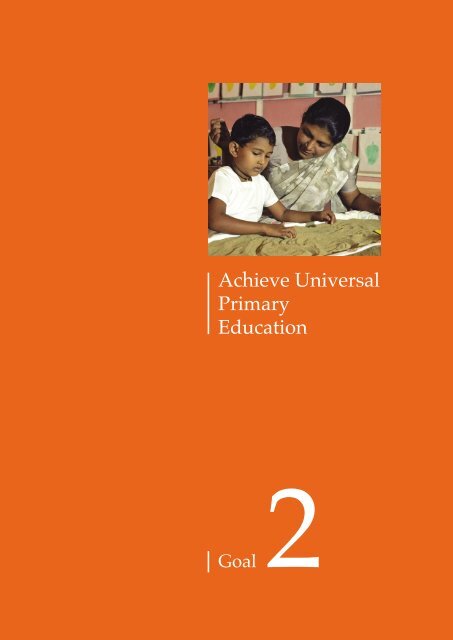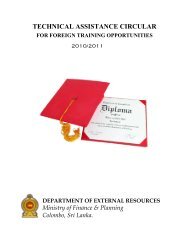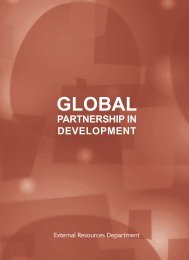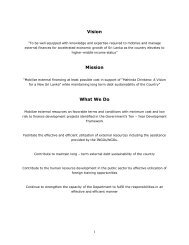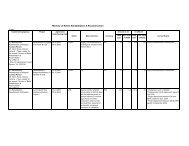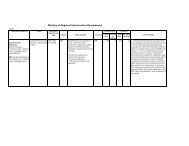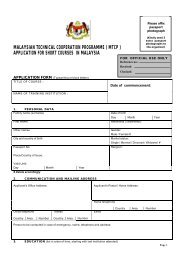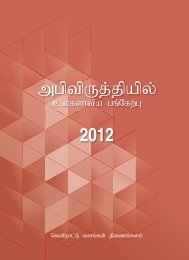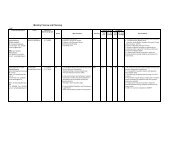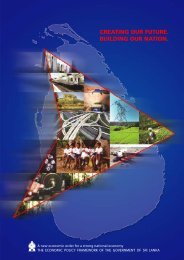Goal 2 : Achieve Universal Primary Education
Goal 2 : Achieve Universal Primary Education
Goal 2 : Achieve Universal Primary Education
- No tags were found...
Create successful ePaper yourself
Turn your PDF publications into a flip-book with our unique Google optimized e-Paper software.
<strong>Achieve</strong> <strong>Universal</strong> <strong>Primary</strong> <strong>Education</strong>35Target 3Ensure that by 2015, Children Everywhere, Boys and Girls Alike, Will be Able to Complete a Full <strong>Primary</strong>SchoolingScorecardIndicator 1990 2002 2015 MDG target% % % status6. Net enrolment ratioin primary school 91.7 96.4 100 On track7. Proportion of pupilsin grade 1 whoreach Grade 5 92.7 97.6 100 On track8. Literacy rate of15-24 year olds 92.7 95.6 * 100 On trackSource: (6) - QLFS/DCS, 6 -10 year olds(7) - Ministry of <strong>Education</strong>(8) - HIES, PHC 2001/DCSStatus and Trends<strong>Education</strong> in Sri Lanka is viewed as a basic right and thegovernment from as early as 1943, adopted policies toencourage schooling amongst children. Schooling for 5-14 agegroups was made mandatory by Parliament in 1997. Freeprimary, secondary tertiary education and the establishmentof an islandwide network of primary and secondary schoolswere set up in this direction. Investment in education is atthe heart of Sri Lankan government policies in order toincrease national income, reduce poverty and promote humandevelopment. Government incentives include, scholarships,mid-day meals, free textbooks, material for school uniformsand easy access to a number of schools. Deserving studentsfrom low-income families are also provided with bursariesto meet their other expenses, which are continued up touniversity.The country has an islandwide network of approximately10,475 schools (public, private and pirivenas), which provideopportunities for primary and secondary education.<strong>Education</strong> in Sri Lanka is predominantly state run. The privatesector is very small with only 78 schools in comparison to9,790 government schools. Among these, 3,164 are schoolswith primary grades only, while in most instances primarygrades were sections of schools that also offered post primaryeducation. The student population was approximately4 million in 2003, and on average there is a school for every6 km 2 of the country.Net Enrolment RatioFrom as early as 1980, 85% of school children (6-10 year olds),both boys and girls, were enrolled in schools. Enrolment ratesincreased further after the ratification of the UN conventionon the rights of children, and with the adoption of the NationalAction Plan for Children in 1991 and 2004.Table 11: Enrolment Rates - (6 - 10 years)1995/1996 2002Sri Lanka 95.7 96.3SexMale 95.6 97.1Female 95.7 95.6SectorUrban 96.1 95.9Rural 95.6 96.4Source: HIES 1995/96 & 2002(%)The net enrolment ratio in primary education in 2003 was ashigh as 98.35%. This increased from 95.2% in 1990. The datafrom table 11 shows enrolment rates among males slightlyhigher than that of females. Sector-wise in 2002 there was onlya 0.5% difference between urban and rural enrolment rates.Regional variations across districts in access to primaryeducation are relatively low with net enrolment rates for alldistricts recording over 95%. Anuradhapura, Polonnaruwa,Batticaloa and Kegalle districts recorded 100% enrolment rateswhile Kurunegala and Matale districts have enrolment ratesof 95.7%.Although quantitatively Sri Lanka has credited achievementsin primary school enrolment rates, there is still a percentageof children of marginalised groups that are out of the schoolingsystem. These include children of poor families, those in rural,plantation and urban deprived pockets, street children,orphans, disabled, children dwelling in coastal areas, inprobation centres and those displaced due to the conflict inthe North and East province of the island. In addition, theclosure of small schools in villages that traditionally facilitatedaccess to education, the marginalisation and neglect of theschools of the poor and lethargy in the implementation ofcompulsory education legislation are further such reasons.Millennium Development <strong>Goal</strong>s Country Report 2005 - Sri Lanka
36<strong>Achieve</strong> <strong>Universal</strong> <strong>Primary</strong> <strong>Education</strong>While there have been increases in net enrolment rates overthe years, figure 4 forecasts that at the current rate of increase,Sri Lanka might just fall short of the desired target by 2015.Therefore, further policies need to be adopted by thegovernment to encourage the remaining 3% to enter primaryeducation.Figure 4: Net Enrolment Ratio (6-10 years)At the district level, primary completion rates of more than95% was observed for boys in 18 districts and for girls in 21districts. High drop-out rates are prevalent in low-incomeurban neighbourhoods, the plantation sector, remote deprivedvillages and in the conflict affected North East of the island.While a slightly higher percentage of boys than girls in therelevant age groups enter Grade 1, the drop-out rate for boysis higher than for girls. In 1990, this rate was 3.5% amongboys and 3.05% among girls. This increased to 0.81% and0.54% respectively in 2000.Table 13: Net Enrolment Ratios and <strong>Primary</strong> SchoolRetention Rates (1990-2000)(%)DistrictNet Enrolment Rate <strong>Primary</strong> SchoolRetention Rate1990 2000 1990 2001Colombo 95.8 98.6 96.4 99.9Gampaha 96.4 98.7 98.7 96.8Source: DCSSri Lanka is the best performer in South Asia in terms of itsprimary school indicators. Its net attendance rates are morethan 30 precentage points higher than Pakistan, India andBangladesh where the rates are in the 49-65% range.Kalutara 92.8 97.7 94.9 99.8Kandy 95.0 99.9 96.4 99.4Matale 93.3 95.8 91.8 95.8Nuwara Eliya 91.7 97.7 73.6 96.7Galle 96.2 97.6 95.0 98.5Matara 94.6 97.3 91.4 98.3Hambantota 97.1 100.0 87.5 98.2Retention RateSignificant progress has been made on overall studentretention levels. The retention rate in 2001 was 97.6%, a 6.4%increase since 1990. Retention rates are the highest in theColombo district (99.9%) while the lowest was in Mannar(82.2%). Although the overall completion rates for primaryeducation are high, when disaggregated by gender, it appearsthat more boys than girls drop out after completing juniorsecondary education (Table 12).Jaffna N.A. 99.7 84.4 96.1Kilinochchi N.A. N.A. 90.8 9.9Mannar N.A. 95.9 N.A. 82.2Vavuniya N.A. 97.8 15.1 90.0Mullaitivu N.A. N.A. N.A. 91.2Batticaloa N.A. 100.0 N.A. 91.0Ampara N.A. 97.6 N.A. 95.2Trincomalee N.A. 100.0 76.2 97.9Kurunegala 95.9 95.8 92.8 99.0Puttalam 94.4 96.5 N.A. 96.6Table 12: Completion Rate for <strong>Primary</strong> and Junior Secondary<strong>Education</strong> by Gender - (2001)(%)Stage Male Female OverallAnuradhapura 95.8 100.0 98.9 97.7Polonnaruwa 98.6 100.0 99.4 97.8Badulla 92.4 97.5 84.7 98.4Monaragala 94.7 96.9 95.2 97.1Ratnapura 95.5 99.3 88.2 96.4<strong>Primary</strong> 96.9 98.3 97.6Secondary 79.1 86.3 83.0Source: The Development of <strong>Education</strong>, National Report 2004.Kegalle 97.4 100.0 93.5 98.2Sri Lanka 95.2 98.4 91.7 97.6Source: Calculated from HIES 90/91, HIES 95/96, SLIS 00, and theMinistry of <strong>Education</strong>Millennium Development <strong>Goal</strong>s Country Report 2005 - Sri Lanka
<strong>Achieve</strong> <strong>Universal</strong> <strong>Primary</strong> <strong>Education</strong>37<strong>Education</strong> AttainmentFigure 5: Literacy Rate (15-24 Year)Table 14: <strong>Education</strong> Attainment (1953-2003)(%)1953 1963 1973 1978 1981 1986 1996 2003/79 /82 /87(b) /97(b) /04(b)NonSchooling 41.8 26.8 22.9 14.9 15.1 11.8 8.6 7.4<strong>Primary</strong> 46.8 45.5 43.2 43.8 42.9 41.1 35.2 29.1Secondary 9.8 22.7 27.3 29.8 29.2 32.1 35.5 42.2Teritiary 1.8 5.0 6.6 11.5 12.8 15.0 20.7 21.3Source: DCS(b) Excluding North and East provincesSource: CFSES 2003/2004Map 3: Literacy Rate (5-24 years)The above table shows that in the 2003/04 period the numberof non schooling children was 7.4%. What is noteworthy fromthe data is that while the number in primary schoolingdecreased, those that go on to secondary and tertiaryeducation increased. While primary education attainment isthe highest in the Eastern and Uva Provinces; secondary andtertiary education are among the lowest. This shows thatfewer students are continuing with higher education. Thereasons for non participation are socio-economic, the principalfactor being poverty.Literacy RateThe increase in enrolment and retention rates are reflected inthe rise in youth literary rates in the age group of 15-24 yearolds. Youth literacy rates increased from 92.7% in 1990 to95.6% in 2001. In 2000 at the provincial level the lowest levelsof literacy was observed in the Sabaragamuwa (87.5%) andCentral Provinces (93.8%), where the literacy rates declinedby 6.7% and 0.6% respectively in 1995. At district levelalthough Nuwara Eliya (91.8%), Ampara (93.5%) and Badulla(93.9%) recorded the lowest rates of literacy (Map 3). Figure5 shows that Sri Lanka is already on track in achieving itsMDG target by 2015.Source: DCSMillennium Development <strong>Goal</strong>s Country Report 2005 - Sri Lanka
38<strong>Achieve</strong> <strong>Universal</strong> <strong>Primary</strong> <strong>Education</strong>Teachers in <strong>Primary</strong> <strong>Education</strong>Lack of qualified teachers and disparities in teacherdeployment has lead to a situation where schools, which caterto the vulnerable are faced with acute shortages of teachers.In 2003, 1,501 schools in rural and plantation areas, and 63schools in urban areas had 4 teachers or less per school. Theteaching and learning methods adopted in many of theseschools are traditional and outdated. Many of the teachersare not competent and have not been adequately trained inadopting the curriculum to local needs.Table 17: Proportion of <strong>Primary</strong> Children AchievingMastery of Numeracy Skills - (2003)Skills Sri Lanka Urban Sector Rural SectorConcepts 45 58 42Procedures 51 56 40Problem Solving 34 39 26(%)Table 15: Availability of TeachersTotal 38 52 35Availability No. of schools Rural andof Teachers Urban Plantation1 - 1502 - 3743 - 4714 63 506Source: Ministry of <strong>Education</strong>, 2004Quality of <strong>Education</strong>Sri Lanka’s impressive education indicators mask seriousdeficiencies in the quality and efficiency of education.Cognitive achievement tests among primary schools inSri Lanka show shortfalls in the mastery of basic languageand numeracy skills.Source: Sri Lanka; Development Policy Review, World Bank 2004The data shows that primary students in the rural sectorperformed poorly in comparison to those in the Urban sector.Only 37% of students mastered language skills (Sinhala orTamil), while a mere 10% mastered the English Language.While levels of vocabulary (in the first language) are above60%, written and syntax skills are less than 30% in the RuralSector. Only 38% of students have mastered numeracy skills.These poor education standards are also reflected by the lowpass-out rates in secondary education, for example, between1998-2002, only 37-40% of students passed the GCE O/Lexamination while 47-56% passed the GCE A/L examination.Resource constraints have led to the decline in the quality ofeducation provided in schools as seen in the governments“<strong>Education</strong> For All” Assessments.Table 16: Proportion of <strong>Primary</strong> Children AchievingMastery of Language Skills - (2003)SkillsFirst Language(Sinhala or Tamil)English Language(%)Sri Urban Rural Sri Urban RuralLanka Sector Sector Lanka Sector SectorVocabulary 70 81 68 35 48 30Comprehension45 56 43 16 33 13Syntax 30 44 27 20 34 17Writing 28 40 25 1 4 1Total 37 51 34 10 23 7Children with DisabilitiesThe provincial School Census for 2003 indicates that thereare 58,626 students with disabilities and only 12,407 studentsare catered for in special schools/classes. In the educationsystem 1.8% of male students and 1.2% of female studentswere disabled. Dropout rates among students with disabilitieswas high, with only 56% of those entering grade 1 continuingto secondary grades. At present, there are 25 assisted specialschools catering for 2,789 students with disabilities and 9,618students in special classes in 852 mainstream schools. Thepupil teacher ratio in special schools is 6.7:1 and in specialclasses 10.3:1, indicating that there is a shortage of teacherscatering to this category 3 . Greater attention should be focusedon catering to the needs/requirements of this group.Source: Sri Lanka: Development Policy Review, World Bank 20043 Attaining Millennium Development <strong>Goal</strong>s in Sri lanka, World Bank (2003)Millennium Development <strong>Goal</strong>s Country Report 2005 - Sri Lanka
<strong>Achieve</strong> <strong>Universal</strong> <strong>Primary</strong> <strong>Education</strong>39Access to <strong>Education</strong> for Children in theNorth EastThe conflict has heavily impacted children of the North Eastand all aspects of the education system are damaged.Problems such as non-enrolment, drop outs, absenteeism andpoor learning and teaching is widespread. According to aNeeds Assessment Report 4 of 2003, 50,000 school agedchildren in the North and East are currently out of schooland there is a 15% dropout rate. There is a deficit of 5,000teachers and principals. Approximately 15,000 classrooms inabout 500 schools have been either destroyed or damagedand they lack furniture, libraries and other basic facilities. Withthe returning Internally Displaced Persons (IDPs) the demandfor such services is likely to increase and thus the demand onthe education system would be greater.Present Supportive EnvironmentEnvironment lead suppportive policies include:• Allocating public resources to favour poor geographicalareas where learning levels are low. Public educationspending across provinces is progressive with higherpublic expenditure per student in provinces wherelearning levels are poor. For example, the North and Eastprovince, receives the highest proportionate governmentexpenditure per student on education 5• Policy Initiatives in curriculum, pedagogy and teachereducation and training - This includes modernising theprimary school curriculum along the lines of key stagemodel used in the UK, the curriculum being centeredaround 4 main subject areas (first language, mathematics,religion and environmental studies) and ensuring that allteachers are trained through a three-year pre-service teachereducation course before entering the teaching service• Monitoring and evaluation of education outcomes, withspecial emphasis on the measurement of cognitiveachievement. In this regard the National <strong>Education</strong>Research and Evaluation Centre (NEREC) and theNational Institute of <strong>Education</strong> (NIE) were establishedto develop their individual capacities in a safe andenabling environment. Various policy measures wereintroduced to ensure the provision of quality educationand improvement of access. Such programmes range fromearly childhood care to secondary education, non-formaleducation and the development of education in conflictaffected areas. In addition, programmes are formulatedto protect disadvantaged children such as those abused,disabled, street children, children of migrant mothers andthose in conflict with the law, and to ensure that theyreceive formal education and benefit from social welfareprogrammesChallenges• Extreme poverty is still the main reason for nonparticipationof children at the primary stage. Childrenare employed to supplement the family income and theopportunity cost for education is very high among thesegroups• Literacy of parents who do not value the merits of education• Under-staffing of schools in the distant and disadvantagedareas• Upgrading classrooms and the provision of other basicfacilities have not been adequately implemented. Manyof the schools in Rural Areas and the North East sufferfrom the lack of basic infrastructure facilities such asbuildings, laboratories, libraries and educationalequipment• Reliable information to ascertain the number of disabledchildren is unavailable• Lack of a systematic programme to identify disabledchildren and enroll them in schools• Teachers have not been adequately trained in adaptingthe curriculum to the local needs in order that learning bychildren in school is perceived to be relevant by thecommunity• Lack of quality of the education system in catering to thepresent social and economic needs• Development of a National Action Plan for Children witha medium-term outlook (from 2004-2008). The overallstrategy of this programme is to ensure universal accessto the services that children require for their full and freedevelopment and providing them with the opportunity4 Prepared by the ADB, World Bank and the WFP5 Attaining Millennium Development <strong>Goal</strong>s in Sri Lanka (2005)Millennium Development <strong>Goal</strong>s Country Report 2005 - Sri Lanka
40<strong>Achieve</strong> <strong>Universal</strong> <strong>Primary</strong> <strong>Education</strong>Priorities for Development• Improve infrastructure facilities in small schools in RuralAreas and the North East• To provide eleven years of compulsory education to allchildren as a policy decision to extend the period ofcompulsory education from the present 5 -14 years of age(9 years) to 5 - 16 years (11 years)• Compulsory Attendance Committees at Schools (CACS)and School Attendance Monitoring Committees (SAMC)need to be reactivated and the convening of suchcommittees should be entrusted to the state educationauthorities• Enrolment rates in the primary stage is high; howeverparticipation at secondary levels need to be improved.Reform and expansion of the higher education system isnecessary to widen the skills base and allow greater access• Quality of education - The learning achievements ofstudents need to be improved upon. Mastering of basiclanguage, numeric skills and other subject areas such asscience and social studies need to be improved at theprimary level. There is also a need to develop generalcompetencies among students in addition to the basictextbook teaching methods. The need to improve IT amongschool children, especially among those in the Rural Areasis important. There is also a need to match education tothe needs of the labour market to create new opportunitiesand future growth. In this regard practical skills andcommand of the English language needs to be improveduponcontinuously over the full term of their professional career.To attract qualified teachers and increase retention,measures to motivate them such as better salaries, workingconditions, improved autonomy and responsibility andpromising career prospects should be provided• To include children with disabilities, the destitute andabandoned, street and working children in to the educationsystem• Financial allocation for education has to be regularlyincreased to maintain equity and excellence. Anexamination of the past allocation of funds for recurrentand capital expenditure in education reveals that theproportion of recurrent expenditure is in the range of 80%while capital expenditure is around 20%. A large portion(75%) of the recurrent expenditure goes for teacher salaries.The reduction of capital expenditure contributes towardsa serious decline in the quality of education at all levels.The inequitable allocation of resources widens thedisparity among ever-expanding urban schools and therural and small schools that meet the education needs ofthe disadvantaged communities. Resource allocationshould be fair and transparent• North and East - Schools in the North and East need specialattention in terms of teacher supply, restoration of physicalinfrastructure, cater to the special needs of childrenaffected by the conflict, providing of non-formal education,school feeding programmes, and pre and higher educationfacilities. Special catch up programmes should also beimplemented to fill the lacunae of two decades of exclusion• Teachers - Focus should be placed on proper training anddeployment of teachers, improvement of facilities andtraining of special teachers for the disabled. Teachereducation programmes need to be introduced andincentives provided to teachers to work in Rural Centresto ensure a more equitable distribution of qualifiedteachers. There is also a need to ensure opportunities forteachers to upgrade their knowledge and skillsMillennium Development <strong>Goal</strong>s Country Report 2005 - Sri Lanka


